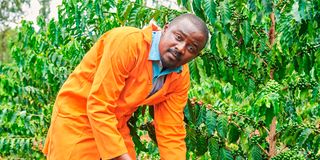Cultivating change: How technology is reshaping Kenya's coffee farming

Harrison Murimi, 34, at his coffee farm in Mwea, Kirinyaga County on February 1, 2025.
What you need to know:
- Increasingly unpredictable weather patterns demand adaptive, data-driven agricultural strategies.
In the lush, rolling landscapes of Kirinyaga County, a quiet revolution is brewing - one coffee plant at a time. Harrison Murimi represents a new generation of Kenyan farmers, where traditional agricultural practices meet cutting-edge technology, promising a future that is both innovative and hopeful.
At 34, Mr Murimi, a resident of Kutus village in Mwea, is an unlikely agricultural entrepreneur. By day, he teaches history at a local secondary school. By afternoon and weekend, he transforms into a tech-savvy coffee farmer, managing five acres of meticulously cultivated coffee plants.
His journey is more than a personal success story; it's a blueprint for how young Kenyans can reimagine agriculture in the face of economic challenges and climate uncertainty.
"Money is in the soil," Mr Murimi says, his eyes scanning his carefully maintained coffee plantation. "Agriculture isn't just about farming. It's about transformation."
His path to farming was born of necessity and opportunity. After completing his secondary education, Mr Murimi faced the harsh reality many Kenyan youth encounter - limited financial resources for higher education. His father, recognising the potential in their small family land, made a pivotal decision. He leased out coffee stems to raise money for Mr Murimi's university education, a sacrifice that would ultimately set his son on a remarkable trajectory.
“I saw my dad leasing the coffee stems to somebody else for a period of six years so that he would raise school fees for me to go to the university. I had stayed home for three years after sitting my Kenya Certificate of Secondary Education exams. I had passed but could not join university because of financial constraints,” Mr Murimi says.
With a bachelor's degree in Education Arts from Laikipia University secured, Mr Murimi received a portion of family land. What began as 80 coffee stems quickly grew to 5,000 plants spread across five acres. But it's not just the quantity that's remarkable - it's how he farms.
“If you look at the current land prices in Kirinyaga County, they are so high to be managed by a young person who is not financially stable like myself, but I can comfortably lease because that is more affordable for me,” Mr Murimi admits.
"Technology has completely changed my approach. Where traditional farming required three people to spray one acre all day, I now use mechanised pumps that complete the same task in under two hours with just two people."
His technological arsenal includes advanced irrigation systems powered by electricity, modern spraying equipment, and a game-changing mobile application called Yara Farm Care. This tool provides precise weather predictions and fertilisation guidance, allowing the teacher to optimise his farming practices with unprecedented accuracy.
"Knowing exactly when to apply fertiliser, understanding rainfall patterns - these aren't luxuries. They're necessities for modern farming," he says.
The application represents more than just a technological tool. It's a gateway to global agricultural knowledge. Mr Murimi can research best practices, verify product authenticity, and make informed purchasing decisions - all from his smartphone.
This approach is critical in an agricultural landscape where smallholder farmers often struggle with limited resources and information. According to the Transforming Ecosystems for Jobs in Agriculture through Technology and Innovation (Tejati) initiative, Kenya's agricultural sector is ripe for technological disruption.
William Ng'eno, country manager at Yara East Africa, highlights a significant challenge: "Most young people view agriculture as a path to poverty. They need to see economic potential."
According to Mr Murimi, the use of technology in agriculture requires more funds, which he still lacks, and that limits him from going fully into mechanised coffee farming. As a result, he creates employment by hiring a number of local people who weed his five-acre coffee farm every weeding season.
“I hope that I can get to harvesting using machines as I advance. I am also thinking of value addition, where I can do my own pulping, and make my own coffee for consumption, which I can also sell. Currently, I am only doing the production of coffee on the farm and selling to local cooperative farmers,” says Mr Murimi.
"Each technological intervention is a calculated risk," he explains.
"But the potential rewards far outweigh the initial investment."
His approach aligns with broader national goals. Tejati aims to create 500,000 agricultural jobs annually by promoting technological innovation.
Mr Murimi represents the prototype of this vision - a young, educated professional choosing agriculture as a viable career path.
The global coffee market offers additional motivation. With Kenya renowned for its high-quality Arabica beans, there's significant economic potential for innovative farmers. Mr Murimi is already planning value-addition strategies, including on-site coffee pulping and direct marketing.
"I'm not just growing coffee," he says. "I'm building a sustainable agricultural business."
His journey has not been solitary. Training programmes by organisations like Yara East Africa have been crucial. These initiatives provide technical knowledge, connecting young farmers with global agricultural innovations and best practices.
For Mr Murimi, technology isn't about replacing traditional farming knowledge but enhancing it. He credits his father's initial teachings and continues to learn from experienced local farmers. The mobile application and modern equipment complement, rather than replace, generational wisdom.
“This technology is relevant to me since I need to know when I am expecting the rains because we do apply fertiliser during the rainy season; and we need to apply the right amount of fertiliser at the right time so that we get the maximum production,” Mr Murimi tells Climate Action.
Like other coffee farmers, Mr Murimi says that he applies fertiliser on the soil and also on the leaves at different stages of the coffee's growth. Considering that he is mostly not at the farm because of his teaching career, using technology helps him to order and pay farm inputs like fertiliser whenever he needs them, hence saving him time.
Climate change adds urgency to this transformation. Increasingly unpredictable weather patterns demand adaptive, data-driven agricultural strategies. Mr Murimi's approach - leveraging technology to monitor and respond to environmental changes - offers a glimpse of agricultural resilience.
As the afternoon sun bathes his coffee plantation, Mr Murimi reflects on his journey. "Ten years ago, this seemed impossible. Now, it's not just possible - it's happening."





